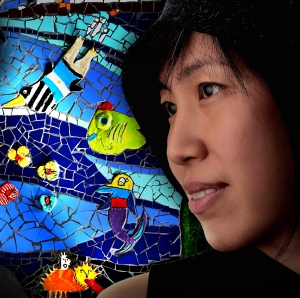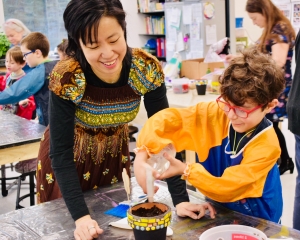ACE Artists in Education: Lisan Chng
Lisan Chng is a mosaic artist, facilitator, coordinator and initiator of community mosaic projects and participatory art. She created and coordinated the ELAN Artists Community Education Initiative (ACE) project, “Magic Pots and Talking Mirrors” at Métis Beach School, in Métis Beach, Quebec, this year. This interview took place when Lisan was completing her project at Metis Beach School.

Photo: Bertin Bélanger
ELAN ACE: What is your practice?
Lisan: My practice is predominantly focused on community-building through mosaic-making. I like the journey of bringing people together through art. In Quebec, this is also considered as cultural mediation, which is the process of building bridges between the cultural and social realms. In my work, I feel like I’m the glue. I bring people together, like tile pieces. In both my life and my work, though the vision isn’t always fully formed; it develops as I bring projects, people and stories together.
ELAN ACE: How have you incorporated the ELAN ACE concept into the project you are currently involved in?
Lisan: Before ACE came into my life, I was facilitating community art projects intuitively. But since knowing ACE’s Lead Consultant, Christie Huff, and Project Consultant, Paula Knowles, I’ve really focused on taking more care into connecting the people who are involved in my work. The community-building focus of ACE allows me to focus on being more conscious of the kinds of partnerships I am building and take more care in nurturing the relationships between people. I think that the ACE model has made community-building more structured for me and equipped me with tools and ideas that I can use in this project and in future projects.
ELAN ACE: Can you describe the project you are working on?
Lisan: When I was developing the project, I had a few goals. First, I wanted to bring seniors into the community project and connect them with the kindergarten and grades 1-2 students. I also wanted to focus on bridging connection with the linguistic community and between older and younger people beyond their nuclear families. My project is called “Magic Pots and Talking Mirrors”. I first taught the seniors how to create mosaic mirrors, which express their life stories. They learned some basic mosaic skills and were then able to help the students in the making of mosaic pots. The pots were chosen for the students because gardening is important for the community. With the pots, the students learn to tend and grow as well. As the project developed, the art teacher at Metis Beach School, Ms. Lynn Fournier, and I wanted to bring students from Grades 3-4 students into the project as well. In our process of research for additional funding, we found the OseEntreprendre Challenge. At this point, we thought that it would be interesting to challenge the older students to develop the entrepreneurial mindset; we could sell the pots at the farmers’ market. The older students were challenged to create and add features to their pots to make them more compelling for sale. So, it was a project with a base, and it really grew from that. With Culture in Schools, New Horizons For Seniors and ELAN ACE‘s support, we were able to expand the intergenerational project to include the kindergarten, grades 1-2, and grades 3-4. The project started its CREATE phase at the beginning of February. All of the creating work is done, and we now will sell some of these pots with the students in May and June. Some of these pots already have interested buyers! For the younger kids, they could each bring a mosaic pot home, planted with seeds and soil, and give it to their mother for Mother’s Day. All this is made possible with the help of senior participants who chipped-in their time to assist the students in the process.

Photo: Melissa Landry
ELAN ACE: How do you see the students, teachers and community at large growing through the project that you are working with growing through your project?
Lisan: First of all, I’ve never worked with students this young before on difficult process like grouting. Lots of artists wouldn’t even go there. I think that my naivety and the support of the teachers have let me expose the students to something that they haven’t experienced before. It is a project that the students have really learned from, and which has also challenged me in my teaching. I’ve been very lucky to work with artist and art teacher at Metis Beach School, Ms. Lynn Fournier, who has inspired me a lot in the way she teaches art to her students. A lot of the credit for the project’s success goes to her, as we brainstormed together on how to develop the project. It is not easy to have community and another artist come into your class as it can be a lot to manage; Ms. Fournier’s willingness and openness to bring the generations together is pivotal. The seniors’ involvement and presence turned out to be really generative and helpful. There was also an excellent synergy between the math teacher and art teacher, Ms. Fournier, in developing a method to combine curriculum objectives while enacting this project. We were like, hey, it actually makes sense to teach math through art! For the community, I think the community-building aspect pushed some people out of their comfort zone in positive ways. For example, there was a senior who was French-speaking who initially thought that she may not be comfortable working with students in English in an English-speaking school. Another senior participant thought she was not good with working with children. They came and thoroughly enjoyed and learned from the process.
ELAN ACE: Can you think of an example of co-learning that you witnessed and participated in through this project?
Lisan: I didn’t really plan for my project to incorporate co-learning, but it has really developed that way on its own. I am just really impressed with the community’s intelligence. When I first came to this project, I was nervous that I was going to have to bear a lot of the project. As I’ve progressed, I’ve realized that you open the space to have people connect and then their intelligence comes in, and all I have to do is be observant of the learning. For example, when one student gets an advanced concept of cutting or mosaic setting, she gets it done on her pot. Soon, other students see the results and they get up to speed as well. Because we spend more time with the students on techniques and concepts, as the seniors accompany them, they learn and pick up the knowledge as they help the young ones well. We are all learning and absorbing all the way through the project. As we get towards the end of the project, we see the learning accelerating and the production too. It is really quite amazing how the learning becomes concrete and how we all influence each other in a collaborative environment.
ELAN ACE: What is your vision of the future relationship of the arts to education? What do you think is the value of integrating the arts into education?
Lisan: Honestly, I take it for granted that that is the way that the future of education will develop. I see art being so vital. I think that the direction of art now is so community-oriented, and out of the galleries. Art is now used for healing, for community building. The value I see in including art in education is that it helps to address the issue that different students learn differently. Our academic systems really only value certain types of learners. In our art project, I see some learners with different abilities pick up on the art project so quickly, even quicker than some adults can manage. In this project, for example, there is a girl with developmental delays who has impressed all the adults in her mosaic skills. On her own, she covered an entire pot with cut tesserae in precise fit, with the motif of her favourite bird in the center. Art taps into different learning abilities. And we have to cater to different learning styles in education.
Lisan Chng’s Website: http://mosaicjam.com
Lisan Chng’s Instagram: @mosaicjam
ELAN Quebec’s ACE Initiative’s Instagram: @elan_quebec_ace_initiative



